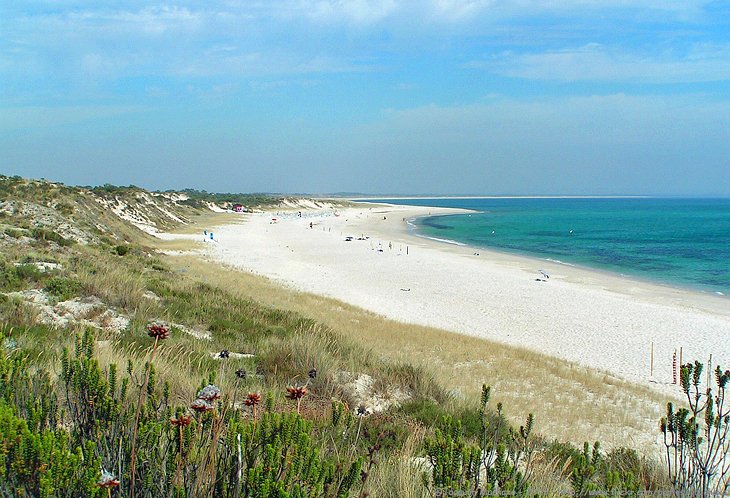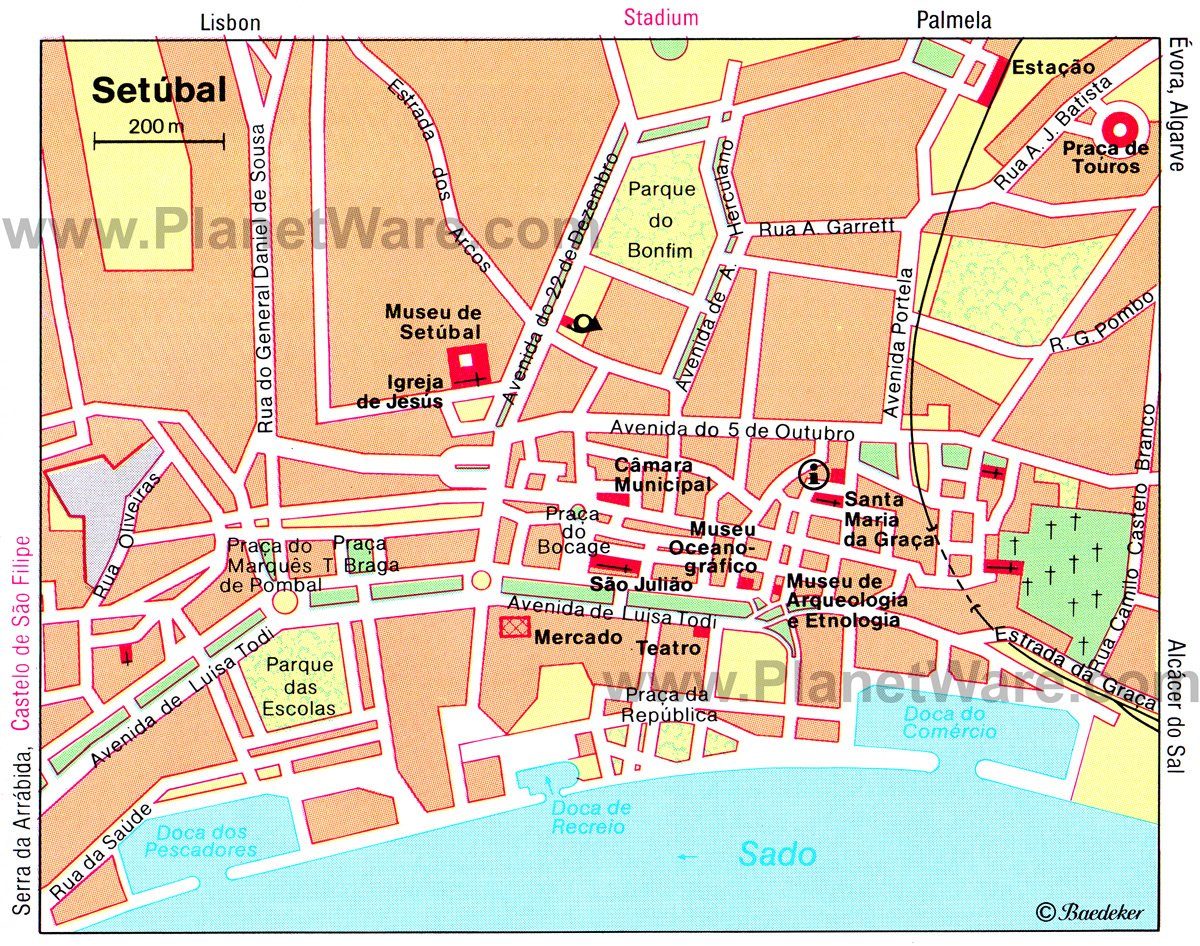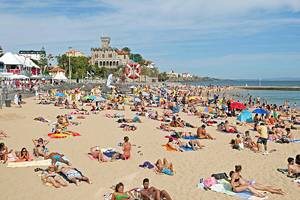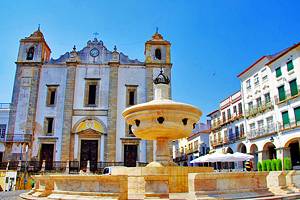Tourist Attractions & Things to Do in Setúbal
Tourists to Setúbal shrug off its image as a busy industrial port as soon as they begin exploring this vibrant and energetic city. Set on the north bank of the River Sado, near the mouth of the estuary, Setúbal's affinity with the sea is immediately apparent. From the castle high above the harbor, the vast Atlantic Ocean rolls out towards a steel-blue horizon.
In the old town, churches are dressed in pleated stone, designed to resemble twisted rope. Along the quay, restaurants serve emblematic dishes like choco frito — deep-fried cuttlefish seasoned with garlic and lemon juice. The estuary itself is a protected nature reserve, a favorite destination for spirited dolphins and wintering wildlife.
Outdoor enthusiasts can hike the beautifully stark Serra, west of the city, and discover hidden chapels and medieval strongholds set amid emerald forests and blankets of flowers. Over the bay, a stylish resort is the gateway to a secluded peninsula fringed by golden beaches and shallow lagoons. Here, they farm and fish as the Romans did, and village life is far removed from the city back across the water.
For more ideas of places to visit, see our list of the top attractions and things to do in Setúbal.
Castelo de São Filipe

Dominating the skyline high above Setúbal is the town's castle. The fort was built in 1595 on the orders of Philip II of Spain and follows a star-shaped design originally drawn up by Italian military engineer Filippo Terzi. Architect Leonardo Torriana, also from Italy, made sure everything fitted into place.
Constructed during the period of Spanish rule, the defensive stronghold kept enterprising pirates and English invaders at bay. After Portuguese Reconquest, heavier more robust walls were added, as was a stone tunnel that lead to the interior.
Today, it is tourists that besiege the castle, either to clamber playfully over the weathered bastions, or to stay at the pousada, an upscale inn that's made good use of the 16th-century blueprints.
A small chapel lined with wonderfully detailed tiles is worth admiring. But the real draw is the inspiring panorama that takes in Setúbal, the sparkling Sado estuary, and the distant Tróia peninsula.
Reserva Natural do Estuário do Sado

Ornithologists flock to the Sado Estuary Natural Reserve. The 23-hectare wildlife park is home to an astonishing variety of bird species; around 220 have so far been recorded in areas of open water, the shallow lagoons, reed-beds, and across the mud flats.
The estuary is an important wintering ground for razorbill, marsh harrier, flamingo, purple heron, and black-winged stilt, among many others. (Serious birders need to be here from October to February for the best photography opportunities.)
Mammals such as fox, badger, mongoose, and the elusive genet roam the countryside. But it's the resident bottlenose dolphin population that captures the imagination of most visitors. The estuary is their location of choice, as it offers both food and shelter. This is good news for those who want to get up close and personal with these graceful and intelligent creatures, with several sightseeing cruise operations based out of Setúbal and Sesimbra, including the Dolphin Watch Tour in Sesimbra.
Address: Porto de Abrigo de Sesimbra, Avenida dos Náufragos, Sesimbra
Museu de Arqueologia e Etnografia
This modest museum is big on archaeology, and is also noted for its spirited collection of ethnography. The permanent exhibition reaches far back into prehistory, with simple stone tools from the Paleolithic period among the earliest items on show. More discernible are the Bronze Age pots and Roman coins. A number of amphorae are on display, while the mosaic panels, also the result of Roman handiwork, remain one of the museum's highlights.
Visitors should also note the unusual 19th-century devotional paintings on wood depicting holy visions and miracles. Local and regional arts, crafts, and industries make up the majority of the quirky display of ethnography — the traditional costumes are delightful, and the assortment of ships and watercraft are the envy of any scale model boat enthusiast.
Address: Avenida Luisa Todi 162, Setúbal
Igreja de Jesus

Admirers of Manueline architecture will be smitten by the filigree masonry that decorates this church. The monastery, which stands forlornly to the north of the old town, is one of the first buildings in Portugal built in the Manueline style — the Portuguese version of Late Gothic that flourished in the 16th century during the reign of Manuel I.
Designed by the architect Diogo Boitac in 1494, the church stands as a suitable monument to the burgeoning tendency to use maritime motifs in architecture, such as plaited colonnettes to resemble twisted rope inspired by Portugal's Age of Discovery. Use your imagination, and the interior columns resemble giant sticks of candy, the intricate ribbed vaulting decorating the ceiling like a giant spider's web.
The adjacent convent has been turned into a museum that includes a noted collection of Portuguese and Flemish paintings from the 15th and 16th centuries. The highlight is the 14-panel depiction of the life of Christ by Jorge Afonso.
Location: Praça Miguel Bombarda, Setúbal
Castelo de Palmela

The Moors defended it with frightening ferocity before Christian forces eventually conquered it, and the castle at Palmela is still in remarkably good shape since hostilities ended in the 12th century. Strategically positioned over this quaint hill town, the fortress underwent a facelift in 1423, when King João I expanded and strengthened the walls and then transformed much of the building into a monastery.
Today, this is a stunningly attractive pousada, a hotel of cultural significance. The castle's formidable ramparts can still be explored, and visitors can climb the 14th-century keep to capture envy-inducing views of the surrounding Serra da Arrábida: on a clear day even distant Lisbon is brought into focus. For the best images of the castle, wait until dusk, when floodlight bathes the walls in a copper wash.
Palmela itself is fairly unremarkable, although any walk should include a visit to the church of São Pedro, where some fine 18th-century azulejo (tile) panels adorn the interior.
Parque Natural da Arrábida

The wild and undulating Serra da Arrábida Natural Park melds a verdant swathe of beautiful countryside with a dramatic Atlantic Ocean coastline. One of the great natural attractions of the area, the spectacular scenery comprises a pristine landscape rich in cork wood, pine, and eucalyptus forests, thickets, meadows, and blankets of aromatic shrubs.
Hikers will have a field day following the marked footpaths. Cyclists, too, will enjoy the empty lanes and secluded nature trails. Precipitous limestone cliffs, hidden caves, and half-moon coves help define Arrábida's coastal character. Pockets of golden sand attract sun-seekers, and a crystal-clear sea lures scuba divers and snorkelers and other water sports enthusiasts.
A popular destination is Portinho da Arrábida, reached by vehicle down a steep narrow road. Its pocket-sized beach overlooks the rocky outcrop of Pedra da Anixa. Nestling above the hamlet is the Museu Oceanográfico, a fascinating Sea Museum and Marine Biology Center housed in the 17th-century Fortaleza de Santa Maria.
The park's rugged and untamed environment deserves thorough exploration and this is best achieved by joining an organized tour of Arrabida National Park.
Address: Museu Oceanográfico, Fortaleza de Santa Maria, Portinho da Arrábida
Explore nearby Sesimbra

Scenic Sesimbra sits in a sheltered south-facing bay under the slopes of the Parque Natural da Arrábida, about a 40-minute drive from Setúbal. Combining fishing village character with a lively, seasonal resort vibe, the town boasts an attractive old center — a warren of cobbled lanes radiating from the 17th-century Fortaleza de Santiago, once the seaside residence for the Portuguese monarchs. The fort's handsome terrace is open to the public during the day.
Fronting a wide sandy beach, the esplanade is lined with a plethora of cafés, and one or two excellent seafood restaurants, and makes for a pleasant walk. Exemplifying Sesimbra's vibrant personality is the fleet of fishing boats bobbing in the harbor, the Porto do Abrigo.
One of the other rewarding things to do in Sesimbra is the trek up to the restored Moorish castle, set high above the town. The fabulous panoramic views from the sturdy battlements are worth the steep, huff 'n' puff hike, and there's a café to relax in afterwards.
Convento da Arrábida

Enjoying the most idyllic setting of any sightseeing attraction in the area, this 16th-century monastery is half-hidden among the trees of the Serra da Arrábida.
Founded in 1542, the whitewashed cluster of buildings replete with terra-cotta roofs in fact surround two monasteries. The ruins of the old convent sit on the uppermost part of the hillside and are in sad decline; the later building — in much better shape — occupies land farther down the slope.
The newer Franciscan retreat overlooks the Atlantic Ocean, and the spectacular views are reason enough to venture out to this secluded destination. A tour of the premises, however, will reveal the four chapels and a series of tower-like shrines, probably used for meditation, that lie within the grounds. A number of cells, hewn out of the limestone rocks, can also be visited.
The monastery's interior is, for the most part, unremarkable save for the gilded woodwork and azulejo (tile) panels that embellish the walls.
Address: Serra da Arrábida, Azeitão
Official site: http://www.foriente.pt/137/history.htm
Drive or Take a Ferry to Península de Tróia

Opposite Setúbal is the long, thin Tróia peninsula, actually in the Alentejo region. Easily accessible by car or passenger ferry, this inviting destination has the best beaches in the vicinity: the swathes of golden sand on the western edge stretch the entire length of the spit.
Sitting at the northern tip is Tróia itself, an exclusive resort made up of hotels, apartments, a marina, and a nearby golf course. Stylish cafés and bistros line the boardwalk.
The peninsula's eastern flank is dotted with traditional fishing villages and overlooks the warm, shallow waters of the protected Reserva Natural do Estuário do Sado, a haven for birdlife and schools of friendly bottlenose dolphins, which can be observed during specialized sightseeing cruises that pick up passengers at the Tróia pontoon.
Rice paddies are everywhere, cultivated next to reed-beds and marshland. The Romans felt at home here and founded Cetóbriga to farm fish. Farther south at the heel of the peninsula is picturesque Comporta, known for its nesting white storks and one of the top beaches in Portugal where a collection of wood-decked restaurants specialize in grilled fish and seafood.
Day Trip to Cetóbriga

The Romans founded Cetóbriga in the late 3rd century AD in order to establish a fish-salting business, and the town flourished. Traces of the stone tanks used in the process are still clearly visible, as are foundations of the many houses and commercial premises that sprung up in and around the town center. The ruins of baths, several villas, and a number of tombs are also evident, as is patchy mosaic and marble lining.
Cetóbriga was a busy port, and while the factories used for making condiments have disappeared, vestiges of the columns that would have supported the roofs are discernible.
Information panels in Portuguese and English enhance the sightseeing experience by explaining the town's history and the industry that generated its wealth.
Elaborate artist's impressions illustrate how the complex would have looked and help recreate what was undoubtedly a bustling and enterprising community.
You can visit independently or as part of a pre-booked guided tour.
Tour the Sites of Évora

Around a 60-minute drive southeast of Setúbal, the Alentejo's stunning regional capital is one of Portugal's most historic and appealing cities. Culturally rich and blessed with a noble heritage, Évora's old center comprises a fascinating assortment of monuments and museums, a treasure trove of visitor attractions embraced by medieval walls and thousands of years of history.
Standing at its very heart is the graceful Roman Temple, a suitable place to begin exploring. The handsome Palácio dos Duques de Cadaval, impressive Sé or cathedral, and the highly regarded Museu de Évora are all within easy walking distance.
Map of Tourist Attractions & Things to Do in Setúbal
Frequently Asked Questions

How do I get from Lisbon to Setúbal?
Located 48 kilometers southeast of Lisbon, Setúbal is a leisurely 40-minute run along the A2 tolled motorway. The route takes you over the landmark 25 de Abril Bridge.
There are excellent public transport links between Lisbon and Setubal. CP trains operate a direct service out of Santa Apolónia railway station, with trains running every hour or so.
Several bus companies out of Lisbon serve the destination. Transportes Sul do Tejo express buses depart daily from Lisbon's Praça da Espanha and Gare do Oriente stations. Rede express buses depart Lisbon's Sete Rios terminal several times a day.
Which are the best beaches near Setúbal?
Praia do Ouro: The "Golden Beach" lives up to its name as one of the area's finest stretches of sand. Fronting the seaside resort town of Sesimbra, the beach, generous in dimensions, gently slopes towards shallow, clear water. Praia do Ouro is noted for its ease of access for people with reduced mobility.
Praia do Ribeiro do Cavalo: With its picture-perfect looks and relative seclusion, this beach is a delight to discover. Set in a cove and hemmed in by sheer cliffs, Praia do Ribeiro do Cavalo is not easy to reach. In fact, most people arrive here as part of a coastal Serra da Arrábida hike, or by boat from Sesimbra. You can also kayak out of Setúbal to paddle along an extraordinary coastline line pocked with caves and grottos.
Praia da Comporta: Another beach of note is Praia da Comporta — but you'll need to cross the Sado estuary by ferry to the Tróia Peninsula to reach it.
The peninsula, a narrow spit of sand that is actually part of the Alentejo, is fringed on the Atlantic side by a seemingly endless beach. The farther south you travel, the quieter the sands. And Comporta is magnificent, an enormous swathe of soft sands served by a scattering of seasonal beach café-restaurants.
Which are the best golf courses near Setúbal?
Tróia Golf: Located on the Tróia Peninsula, the championship course is a spectacular links design, and one of the most beguiling golf challenges in Portugal.
Acclaimed American golf architect Robert Trent Jones Sr selected hole 3 of Tróia's golf course as one of the best he had ever designed. No wonder this 18-hole par 72 layout is regularly voted one of the best golf courses in the world.
Which are the top resorts near Setúbal?
Set in the idyllic surroundings of a natural reserve, Quinta da Comporta Wellness Boutique Resort features villas, suites, and rooms all decorated in a chic-rustic fashion to exude an appealing organic and blissfully peaceful atmosphere.
The restaurant offers a menu of seasonal Mediterranean-inspired dishes presented in a contemporary style, with some of the ingredients harvested from an in-house garden.
Guests can take advantage of Quinta da Comporta's wellness retreat, but are also encouraged to explore the immediate vicinity and discover its diverse cultural heritage and inherent charm.
Located on the tranquil Tróia Peninsula, Pestana Tróia Eco-Resort & Residences comprises a collection of wonderfully appointed self-catering villas and apartments, many with their own small private pool.
Guest amenities extend to a small restaurant, public indoor and outdoor pools, multi-sports facilities, and mini spa. The beach is reached on foot in 10 minutes. All in all, a great option for a family vacation.
Setubal, Portugal - Climate Chart
| Average minimum and maximum temperatures for Setubal, Portugal in °C | |||||||||||
| J | F | M | A | M | J | J | A | S | O | N | D |
| 15 8 | 16 9 | 18 10 | 19 11 | 22 13 | 25 16 | 27 17 | 28 18 | 26 17 | 22 15 | 18 11 | 15 9 |
| PlanetWare.com | |||||||||||
| Average monthly precipitation totals for Setubal, Portugal in mm. | |||||||||||
| 109 | 112 | 69 | 64 | 38 | 20 | 5 | 5 | 25 | 81 | 114 | 109 |
| Average minimum and maximum temperatures for Setubal, Portugal in °F | |||||||||||
| J | F | M | A | M | J | J | A | S | O | N | D |
| 58 46 | 60 48 | 63 49 | 66 52 | 71 55 | 76 60 | 81 63 | 82 63 | 79 62 | 72 58 | 64 52 | 58 48 |
| PlanetWare.com | |||||||||||
| Average monthly precipitation totals for Setubal, Portugal in inches. | |||||||||||
| 4.3 | 4.4 | 2.7 | 2.5 | 1.5 | 0.8 | 0.2 | 0.2 | 1.0 | 3.2 | 4.5 | 4.3 |




















